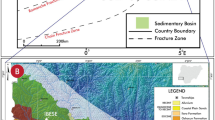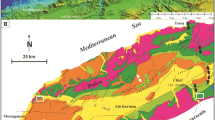Abstract
Chemical weathering and resulting water compositions in the upper Ganga river in the Himalayas were studied. For the first time, temporal and spatial sampling for a 1 year period (monthly intervals) was carried out and analyzed for dissolved major elements, trace elements, Rare Earth Elements (REE), and strontium isotopic compositions. Amounts of physical and chemical loads show large seasonal variations and the overall physical load dominates over chemical load by a factor of more than three. The dominant physical weathering is also reflected in high quartz and illite/mica contents in suspended sediments. Large seasonal variations also occur in major elemental concentrations. The water type is categorized as HCO −3 –SO 2−4 –Ca2+ dominant, which constitute >60% of the total water composition. On an average, only about 5–12% of HCO −3 is derived from silicate lithology, indicating the predominance of carbonate lithology in water chemistry in the head waters of the Ganga river. More than 80% Na+ and K+ are derived from silicate lithology. The silicate lithology is responsible for the release of low Sr with extremely radiogenic Sr (87Sr/86 Sr>0.75) in Bhagirathi at Devprayag. However, there is evidence for other end-member lithologies for Sr other than carbonate and silicate lithology. Trace elements concentrations do not indicate any pollution, although presence of arsenic could be a cause for concern. High uranium mobilization from silicate rocks is also observed. The Σ REE is much less compared to other major world rivers such as the Amazon, perhaps because in the present study, only samples filtered through <0.2 μm were analysed. Negative Eu anomalies in suspended sediments is due to the excess carbonate rock weathering in the source area.








Similar content being viewed by others
References
Aubert D, Stille P, Probst A, Gauthier-Lafaye F, Pourcelot L, Nero MD (2002) Characterisation and migration of atmospheric REE in soils and surface waters. Geochim Cosmochim Acta 66(19):3339–3350
Berner EK, Berner RA (1987) The global water cycle: geochemistry and environment. Prentice-Hall, Englewood cliffs
Berner RA, Lassaga AC, Garrels RM (1983) The carbonate-silicate geochemical cycle and its effect on atmospheric carbon dioxide over the past 100 million years. Amer J Sci 283:641–683
Bickle MJ, Bunbury J, Chapman HJ, Harris NBW, Fairchild IJ, Ahmad T (2003) Fluxes of Sr into the headwaters of the Ganges. Geochim Cosmochim Acta 67(14):2567–2584
Blum JD, Gazis CA, Jacobson AD, Chamberlain CP (1998) Carbonate versus silicate weathering in the Raikhot watershed within the High Himalayan Crystalline Series 26(5):411–414
Braun JJ, Viers J, Dupre B, Polve M, Ndam J, Muller JM (1998) Solid/liquid REE fractionation in the lateritic system of Goyoum, East Cameroon: the implication for the present dynamics of the soil covers of the humid tropical regions. Geochim Cosmochim Acta 62(2):273–299
Chabaux F, Riotte J, Clauer N, France-Lanord C (2001) Isotopic tracing of the dissolved U fluxes of Himalayan rivers: implications for present and past U budget of the Ganges-Brahmaputra system. Geochim Cosmochim Acta 65(19):3201–3217
Dalai TK, Krishnaswami S, Sarin MM (2002) Major ion chemistry in the headwaters of the Yamuna river system: chemical weathering, its temperature dependence and CO2 consumption in the Himalaya. Geochim Cosmochim Acta 66(19):3397–3416
Deberdt S, Castet S, Dandurand JL, Harrichoury JC, Louiset I (1998) Experimental study of La(OH)3 and GD(OH)3 solubilities (25°C and 150°C) and La-acetate complexing (25°C and 80°C). Chem Geol 151:349–372
Dessert C, Dupre B, Francois LM, Schott J, Gaillardet J, Chakrapani G, Bajpai S (2001) Erosion of Deccan traps determined by river geochemistry: impact on the global climate and the 87Sr/86 Sr ratio of seawater. Earth Planet Sci Lett 188:459–474
Dupre B, Gaillardet J, Rousseau D, Allegre CJ (1996) Major and trace elements of river-borne material: the Congo basin. Geochim Cosmochim Acta 60(8):1301–1321
English NB, Quade J, DeCelles PG, Garzione CN (2000) Geologic control of Sr and major element chemistry in Himalayan rivers, Nepal. Geochim Cosmochim Acta 64(15):2549–2566
France-Lanord C, Derry LA (1997) Organic carbon burial forcing of the carbon cycle from Himalayan erosion. Nature 390:65–67
Gaillardet J, Dupre B, Allegre CJ (1999) Geochemistry of large river suspended sediments: silicate weathering or recycling tracer ? Geochim Cosmochim Acta 63(23/24):4037–4051
Galy A, France-Lanord C (1999) Weathering processes in the Ganges-Brahmaputra basin and the riverine alkalinity budget. Chem Geol 159:31–60
Garrels RM, Mackenzie FT (1971) Evolution of sedimentary rocks. W.W.Norton and Co. Inc., New York
Goldstein SJ, Jacobsen SB (1988) Rare earth elements in river waters. Earth Planet Sci Lett 89:35–47
Grosbois C, Negrel Ph, Fouillac C, Grimaud D (2000) Dissolved load of the Loire river: chemical and isotopic characterization. Chem Geol 170:179–201
Harris N (1995) Significance of weathering Himalayan meta-sedimentary rocks and leucogranites for the Sr isotope evolution of seawater during the early Miocene. Geol 23(9):795–798
Ivanovich M, Hermon RS (1992) Uranium series disequilibrium: applications to earth, marine and environmental sciences. Claredon Press, Oxford Press
Karim A, Veizer J (2000) Weathering processes in the Indus river basin: implications from riverine carbon, sulfur, oxygen and strontium isotopes. Chem Geol 170:153–177
Krishnaswami S, Singh SK, Dalai TK (1999) Silicate weathering in the Himalaya: role in contributing to major ions and radiogenic Sr to the Bay of Bengal. In: Somayajulu BLK (eds) Ocean science-trends and future directions. Academia Books International, New Delhi
Martin CE, McCulloch MT (1999) Nd-Sr isotopic and trace element of river sediments and soils in a fertilized catchment, New South Wales. Australia Geochim Cosmochim Acta 63(2):287–305
Meybeck M (1987) Global chemical weathering of surficial rocks estimated from river dissolved loads. Amer J Sci 287:401–428
Negrel P, Allegre CJ, Dupre B, Lewin E (1993) Erosion sources determined by inversion of major and trace element ratios and strontium-isotopic ratios in river water. Earth Planet Sci Lett 120:59–76
Palmer MR, Edmond JM(1992) Controls over the strontium isotope composition of river water. Geochim Cosmochim Acta 56:2099–2111
Pegram WJ, Krishnaswami S, Ravizza GE, Turekian KK (1992) Record of seawater 187Os/186Os variation through the Cenozoic. Earth Planet Sci Lett 91:63–79
Probst A, El Gh’mari A, Aubert D, Fritz B, McNutt R (2000) Strontium as a tracer of weathering in a silicate catchment polluted by acid atmospheric inputs, Strenbach. France Chem Geol 170:203–219
Quade J, Roe L, DeCelles PG, Ojha TP (1997) The late Neogene 87 Sr/86Sr record of lowland Himalayan rivers. Science 276:1828–1831
Ramesh R, Ramanathan AL, Ramesh S, Purvaja R, Subramanian V (2000) Distribution of rare earth elements and heavy metals in the surficial sediments of the Himalayan river system. Geochem J 34:295–319
Raymo ME, Ruddiman WF (1992) Tectonic forcing of Late Cenozoic climate. Nature 359:117–122
Sarin MM, Krishnaswami S, Dilli K, Somayajulu BLK, Moore WS (1989) Major ion chemistry of Ganga-Brahmaputra river system: weathering processes and fluxes to the Bay of Bengal. Geochim Cosmochim Acta 53:997–1009
Sarin MM, Krishnaswami S, Sharma KK, Trivedi JR (1992) Uranium isotopes and rubidium in the Bhagirathi–Alaknanda river system: evidence for high uranium mobilization in the Himalaya. Curr Sci 62(12):801–805
Sholkovitz ER (1995) The aquatic chemistry of rare earth elements in rivers and estuaries. Aqua Geochem 1:1–34
Singh P, Rajamani V (2001) REE geochemistry of recent clastic sediments from the Kaveri flood plains, South India: implications to source area weathering and sedimentary processes. Geochim Cosmochim Acta 65(18):3093–3108
Singh SK, Trivedi JR, Krishnaswami S (1999) Re-Os isotope systematics in black shales from the Lesser Himalaya: Their chronology and role in the 187Os/186Os evolution of seawater. Geochim Cosmochim Acta 63(16):2381–2392
Stallard RF, Edmond JM (1983) Geochemistry of the Amazon 2. J Geophys Res 88:9671–9688
Taylor SR, McLennan SM (1995) The geochemical evolution of the continental crust. Rev Geophys 33:241–265
Valdiya KS (1980) Geology of the Kumaun Lesser Himalaya. WIHG, Dehra Dun, India
Vigier N, Bourdon B, Joron JL, Allegre C (2001) Erosion time scales derived from U-decay series measurements in rivers. Earth Planet Sci Lett 193:549–563
Acknowledgements
Several researchers in Toulouse and Paris extended absolute co-operation in carrying out this work. Professors C.Allegre, B.Dupre, J.Gaillardet, J.Schott, M.Valadoon, R.Freydier, Martin, Damien, Romain, Monique and Caroline are especially thanked for their unfailing support at various stages. Sincere acknowledgements to the French Ministry of National Education for financial support and authorities at IIT, Roorkee for all the co-operation extended. The comments of an anonymous reviewer and the editorial handling by Ann McCarley vastly improved the quality of the presentation.
Author information
Authors and Affiliations
Corresponding author
Rights and permissions
About this article
Cite this article
Chakrapani, G.J. Major and trace element geochemistry in upper Ganga river in the Himalayas, India. Environ Geol 48, 189–201 (2005). https://doi.org/10.1007/s00254-005-1287-1
Received:
Accepted:
Published:
Issue Date:
DOI: https://doi.org/10.1007/s00254-005-1287-1




